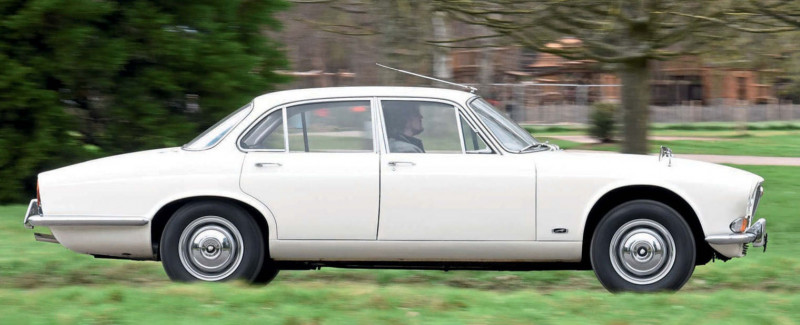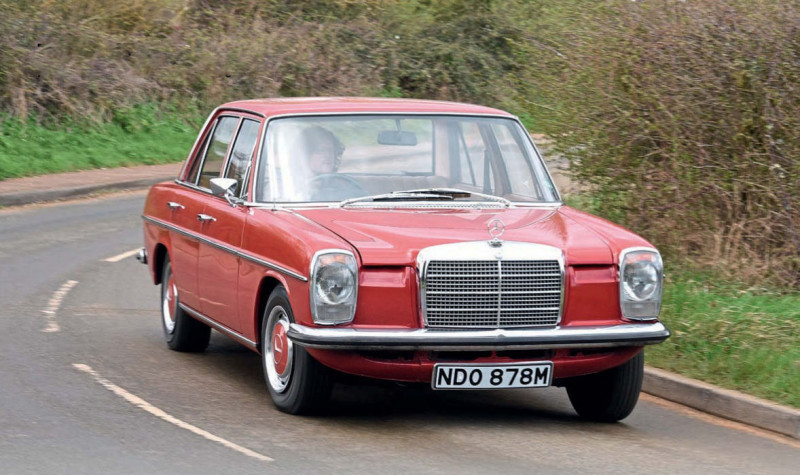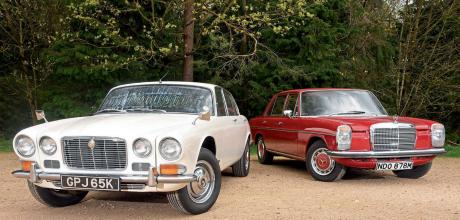1973 Mercedes-Benz 250 W114 vs. 1971 Jaguar XJ6 2.8 Automatic Series 1
If you were an executive in the late Sixties and early Seventies, there was only two choices of car – the Spartan Mercedes-Benz W114 or the prestigious Jaguar XJ6. With both cars worth similar values today, how do the 2.8-litre versions of both compare now?
WORDS SAM SKELTON
PHOTOGRAPHY PAUL WALTON
TWIN TEST Executive decision XJ6 2.8 vs Mercedes-Benz 250 W114 British charm or German reliability?
A comparison of two of the most popular executive saloons from the late Sixties and early Seventies, the XJ6 2.8 and Mercedes-Benz 250 W114
Whetherwe want to admit it or not, a lot of us buy our cars based upon the image they project. We want to be seen as special, separate, exclusive – and this is why sales of the BMW 3-Series began to routinely outstrip those of the Ford Mondeo around the turn of the millennium.

Jaguar drivers aren’t immune either – we might admire the engineering of our chosen cars, but at least some of the decision – whether now or with their first Jaguars – will have been based upon what the car says about its driver.
And Jaguar’s image in the early Seventies was stronger than it had been in a decade. The associations with London criminal types had been shaken off, the range was nearly new in its entirety, and there was an air of quiet respectability to an XJ6 that was lacking in the older Mk 2-based models, and in the giant 420G. Few marques could touch Jaguar in terms of what they said about you. For the £2,617 that an XJ6 2.8 Automatic cost in 1971, a Citroen DS23 Pallas IE would have marked you as eccentric, a Volvo 164 would have marked you as dull, and a Rover P5B would have marked you as old-fashioned. If you wanted to tell the world you had really made it, the Mercedes-Benz 250 W114 offered a similar-sized engine and car to the Jaguar – but cost almost 20 percent more. That put the Mercedes firmly in the ‘company director’ salary bracket – but was it really a better car than the Jaguar? And moreover, could it justify the hefty increase in price?

Mercedes-Benz launched its W114/W115 series in 1968 – mid-sized saloon cars in what we would now consider to be the E-Class family. Styled by French car designer, Paul Bracq, they pioneered a new suspension system for the company utilising semi-trailing rear arms and a ball-joint front end, which would see service under the next-generation S-Class and under the SL which would remain in production until the end of the Eighties.
The W115 was the economy model; typically four-cylinder and less well equipped, while the W114 was the prestigious six-cylinder model. Known when new as the ‘/8’ models – derived from a similar marking on their chassis plates denoting their 1968 introduction – the ‘Stroke 8’ saloons earned a reputation for solidity, reliability and good engineering. The W114 models ranged from the 230.6 (to differentiate from the four-cylinder 230.4) through to the fuel-injected 280E. Mercedes offered a saloon, while there were pillarless coupe variants known as the 250C/CE and 280C/CE.

Mercedes facelifted the W114 for 1973, with a lower bonnet, wider grille, revised bumpers, and removal of the quarter windows to the front doors. There were also new taillights, inertia-reel belts, and a revised A-pillar design intended to help keep the side windows clear. A new padded steering wheel completed the updates. For 1976 Mercedes-Benz launched a new midsized saloon range, the W123 – looking and feeling like an evolution of its predecessor, this car would carry the Mercedes-Benz range into the Eighties.
Like the Mercedes, Jaguar launched the XJ6 in 1968. It was an effort to rationalise what was a somewhat complex range of saloon models – the 240 and 340, the 3.4 and 3.8 S-types, the 420, and the 420G – six models which could be rationalised into a single range of two models. Jaguar had intended a new 3.0 six and a V12 for the car, but neither engine was ready – instead, the XK unit was fitted in 2.8- and 4.2-litre guises, and the V12 would follow for 1972. The car had been styled by company founder, (Sir) William Lyons, in a process which evolved from what had begun as a four-door E-type and would eventually resemble a modernised 420. While the reduction to a single-model range did leave buyers of some of the company’s cheaper models without a natural replacement the XJ6 was an instant hit – more so when the Daimler V8-250 and Daimler Sovereign had been replaced by the XJ6-derived Sovereign 2.8 and Sovereign 4.2 accordingly. The launch of the V12s meant that Jaguar could reasonably lay claim to the title of best car in the world, and many thought that the Rolls-Royce Silver Shadow might lose the crown – especially when long-wheelbase variants and a new range-topping Daimler Double-Six Vanden Plas were added to the XJ range for 1972.

The Series 1 XJ was replaced in 1973 with the Series 2, which from 1974 would only be produced in long wheelbase and new coupe forms – but the ‘Series’ XJ6 would continue in the same basic form until the end of Series 3 production in 1986. The XJ6 was replaced by the new XJ6 – developed as the XJ40, with new engines and an all-new body. Even then, the V12 would continue for a further six years.
Two cars with similar sales periods, similarly-sized engines and price tags appealing to the similarly wealthy, then – the Jaguar appealed to those who wanted something flash that drove well, while the Mercedes appealed to the more subtle customer who prized quality over driver satisfaction. And while the Jaguar’s larger 4.2- and V12-engined variants might have been closer to the Mercedes on price, it’s the 2.8 we feel makes the most interesting comparison today as it represents the closest rivalry between the two companies in the early Seventies. Which of the two would have made a better buy when new? And which makes for a better classic today?
You can see a clear evolution from Mk 2 to 420 to XJ6 if you look, but viewed on the face of it there was a sea change between the Jaguars of the Sixties and the XJ range which would eventually replace them. The one thing the XJ kept was the sense of animal aggression; it may have been a squarer shape but there was still energy in the haunches over the rear wheels, the hoods over the headlamps reminiscent of the pouncing cat which once adorned the bonnet. And at the rear, the small taillamps are one of the few markers which break the simplicity of line – with reversing lamps concealed within a chrome trim and delicate wings in place of a plinth above the rear plate, the rear. aspect of the XJ is simple without being spartan. The radiator grille supports this; lacking a traditionally heavy surround and framed by square horn grilles. Especially in Old English White, there’s a delicacy about the shape which belies its size.
But if simplicity is your thing, the Mercedes is better still. For there are three basic boxes – one for the engine, one for the passengers and one for the luggage. The taillamps are square, the grille is square, the headlamps are oblong. It’s a homage to the simplistic and the rectilinear, with even the fuel filler concealed behind a flap next to the rear registration plate. It’s only in the details that you see where the design flourishes – look at the shape of the doors by the crease halfway down the flanks, and you see flamboyant curvature hidden within what is otherwise a study in Bauhaus design. The Terracotta Red paint supports its vaguely architectural appearance – it’s a shape you can appreciate, but unlike the Jaguar it’s not a shape with which to fall in love with. While both lack fussiness, they cater for very different tastes. Cosmetically, we’d say the Jaguar has the edge over the plainer Mercedes.
Inside, the two cars are very different. While a black interior is contrary to what we might expect of an XJ, the black leather in this 2.8 suits the car well. It not only looks the part, it smells the part too. The dashboard is a clear evolution of the 420 before it – the same plank of polished walnut, the same style of gauges, but for safety reasons toggle switches have been replaced by rocker switches. We like the aluminium trim around the radio, and around the gear selector – adding a sense of modernity to the first of a line subsequently known for its traditionalism. Like subsequent Jaguars, there’s a feeling of cosiness rather than one of supreme space, though in here the feeling is cosseting rather than cramped. Only in the rear does that change, where there’s a smidgen too little headroom for taller passengers owing to the shape of the roof.
The Mercedes is a very different kettle of fish – not only does the tan interior look airier, but the car feels airier owing to a higher roofline and greater shoulder space. There’s no centre armrest in this one, but the stowage box is replaced with a useful carpeted shelf. The trim is simplistic – with Mercedes’ traditional Zebrano wood finish to the dash and an absence of visual frippery elsewhere. The door cards are vinyl, the centre console plastic, the instruments housed in a small pad. But while there's an absence of prestige in here, everything feels phenomenally well put together. The difference between the two cars in static terms boils down to this; you buy the Jaguar if you want to show the neighbours you can afford the finer things in life, while you buy the Mercedes if you want to pay a premium for a car that will last for generations. It's a toss-up between luxury and quality, and we would respect either choice.
And this impression is retained from behind the wheel. Piloting the Mercedes, you don't feel like you're in a design that dates from the late Sixties — it feels more like an early Eighties car as an overall package. The engine pulls well, better than the figures would have you think, while the ride is just on the modern side of cosseting and the steering is nicely weighted. It's perhaps a little lifeless, though — you lack the confidence to throw the Mercedes into a corner, and it's more of a pleasant place to be than an engaging driver's car. This is probably a good thing, as when you do try to push on, it kneels and leans, and you start to worry that the rear end might break away. It's an excellent car, and well up to everyday use even today, but if you want something to throw around you'll be better off with the Jaguar.
Which offers poise beyond the abilities of its drivetrain. The power assistance of the XJ6's steering might be a little too light for real confidence, but there's a lot of grip and the car remains poised however you treat it. It's more like a sports car than a luxury saloon, and the fact that it was still earning praise two decades on shows how good this car would have felt at the tail end of the Sixties. Moreover-, you feel better supported in the seat than on the Mercedes' pew, and there's far more grip available than in the Mercedes in the corners. This was a car designed by drivers for drivers, and it shows. It's just a pity that it lacks the power to use the grip effectively.
Regardless of what the basic figures say, this car doesn't have the power or the torque of the Mercedes, and it's rather more `grace, space, and snail's pace' than Jaguar would want people to think. It will cruise perfectly happily at motorway speeds, but standing start and in-gear acceleration are poor. Several times on test when moving between locations the Mercedes left the Jaguar standing on A-roads, and both editor Paul and I felt that an XJ6 4.2 would have been a closer comparison on the road in terms of performance.
The Mercedes-Benz offers more power and a solid-feeling experience. But we think that the ardent driver would derive a greater pleasure from the Jaguar.
Of the two cars we have on test there was only ever going to be one winner. Both brands are dear to me on a personal level – I grew up in Jaguars, I’ve owned a number of XJs, I still have a late Nineties E-Class Mercedes on fleet, and I was the launch editor of the now defunct title Mercedes Driver. I have no real bias here. But the Mercedes feels like a more complete package than the Jaguar.
For a start, there’s more room inside the cabin for larger drivers, and with the exception of rear legroom the XJ is eclipsed by the 250 in all interior measurements. Even the boot is more ample. It’s also a smaller car and thus easier to live with, easier to park and easier to get into the garage. There’s also the alarming difference in the way the two cars perform.
Where the Jaguar claws a lot of distance back is in its aesthetic and driver appeal as a package. It’s a prettier car inside and out than the Mercedes, and it makes the driver feel more separate than what amounts to a Berlin taxi. It’s also far more engaging when you have wound it up, the steering is sharper and there’s more poise. It’s certainly possible to see why for many the Jaguar would be the winner, with no questions asked.
We said earlier that it was a toss-up between luxury and quality, and we still feel that this is the case. The better built and more practical Mercedes would have made a better new car, but the Jaguar has more soul – and it is sorely tempting to allow the Jaguar’s static and dynamic qualities make it the victor as a classic today. But the engine really lets it down. If we had a 4.2 on test – and new, that would have been a possible option for Mercedes money – the Jaguar would win what would be a very closely matched battle. But in 2.8-litre form, it gives away too much to the Mercedes in objective terms for the subjective to have the deciding vote.
Thanks to: Kim Cairns Classic Cars, Snettisham, for supplying both cars (www.kimcairnsclassics.co.uk)
TECHNICAL DATA 1973 Mercedes-Benz 250 (W114)
- Engine 2,778cc straight-six
- Max Power 128bhp
- Max Torque 159lb ft
- 0-60mph 12.4secs
- Top speed 109mph
- Economy 24mpg
- Transmission 4-spd auto
- Price new £3,125
- Value now £5k-£15k
The ardent driver would derive greater pleasure from the Jaguar
TECHNICAL DATA 1971 Jaguar XJ6 2.8 Automatic
- Engine 2,792cc straight-six
- Max Power 147bhp
- Max Torque 182lb ft
- 0-60mph 10.5secs
- Top speed 114mph
- Economy 22mpg
- Transmission 3-spd auto
- Price new £2,617
- Value now £2k-£9k


